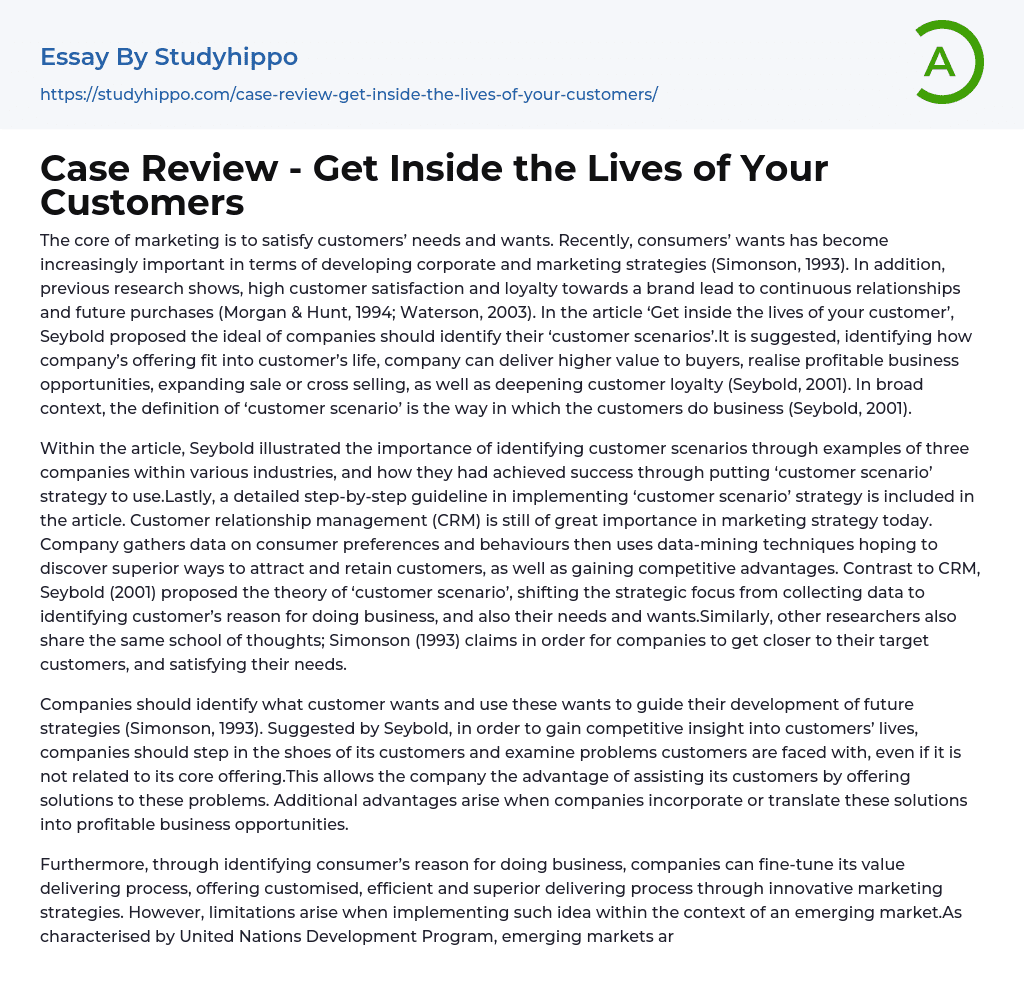

Case Review – Get Inside the Lives of Your Customers Essay Example
The core of marketing is to satisfy customers’ needs and wants. Recently, consumers’ wants has become increasingly important in terms of developing corporate and marketing strategies (Simonson, 1993). In addition, previous research shows, high customer satisfaction and loyalty towards a brand lead to continuous relationships and future purchases (Morgan & Hunt, 1994; Waterson, 2003). In the article ‘Get inside the lives of your customer’, Seybold proposed the ideal of companies should identify their ‘customer scenarios’.It is suggested, identifying how company’s offering fit into customer’s life, company can deliver higher value to buyers, realise profitable business opportunities, expanding sale or cross selling, as well as deepening customer loyalty (Seybold, 2001). In broad context, the definition of ‘customer scenario’ is the way in which the customers do business (Seybold, 2001).
Within the article, Seybold illustrated the importance of identifying customer scena
...rios through examples of three companies within various industries, and how they had achieved success through putting ‘customer scenario’ strategy to use.Lastly, a detailed step-by-step guideline in implementing ‘customer scenario’ strategy is included in the article. Customer relationship management (CRM) is still of great importance in marketing strategy today. Company gathers data on consumer preferences and behaviours then uses data-mining techniques hoping to discover superior ways to attract and retain customers, as well as gaining competitive advantages. Contrast to CRM, Seybold (2001) proposed the theory of ‘customer scenario’, shifting the strategic focus from collecting data to identifying customer’s reason for doing business, and also their needs and wants.Similarly, other researchers also share the same school of thoughts; Simonson (1993) claims in order for companies to get closer to their target customers, and satisfying their needs.
Companies should identify what
customer wants and use these wants to guide their development of future strategies (Simonson, 1993). Suggested by Seybold, in order to gain competitive insight into customers’ lives, companies should step in the shoes of its customers and examine problems customers are faced with, even if it is not related to its core offering.This allows the company the advantage of assisting its customers by offering solutions to these problems. Additional advantages arise when companies incorporate or translate these solutions into profitable business opportunities.
Furthermore, through identifying consumer’s reason for doing business, companies can fine-tune its value delivering process, offering customised, efficient and superior delivering process through innovative marketing strategies. However, limitations arise when implementing such idea within the context of an emerging market.As characterised by United Nations Development Program, emerging markets are countries with an increasing purchasing power parity, low gross domestic product and gross national income per capital. Furthermore, high heterogeneity exists within emerging markets and consumers themselves are perceived to have a low cognitive ability as well as technical skills.
In addition, costs for internet access within South Africa are comparatively higher than other countries.By assessing the examples provided within the article, consumer-reach and the effectiveness of implementing such strategy could be restricted in terms of emerging market context, if target customers have little access to internet. “Thinking in terms of customer scenarios has always been useful, but the arrival of the internet makes the technique more powerful than ever” (Seybold, 2001). With examples provided within the article, it may be suggested that this strategy may be most effective when consumers have full access to internet (For example: online shopping, utilising online programming, transferring documents online).Subsequently
to low internet penetration rate in South Africa, consumers often rely highly on employee’s personal assistance and advices when purchasing complex products. For this reason, for companies operating within emerging markets that wishes to increase customer satisfaction and future purchases.
It is recommended, besides identifying customer scenario and implementing such strategy, companies should rather focus on providing better services through rigorous employee training on identifying and responding to customer’s core need quickly.Thus providing superior services quality and deepen loyalty towards the brand. In conclusion, the proposed ‘customer scenarios’ strategy may be more effective within corporate industries, particularly within high income or well developed countries with high internet penetration rate. Conversely, such strategy may not be as successful when implemented within emerging market context or the retailing industries within South Africa, where internet access is lower and person-to-person contact is still valued highly by its consumers.
References:
- Morgan, R. M. and S. D. Hunt. (1994),”The Commitment-Trust Theory of Relationship Marketing,” Journal of Marketing, 58.
- Seybold, P. B. (2001), “Get Inside the Lives of Your Customers,” Harvard Business Review. Simonson, I. (1993), “Get Closer to Your Customers by Understanding How They Make Choices,” California Management Review.
- Waterson, M. (2003),”The Role of Consumers in Competition and Competition Policy,” International Journal of Industrial Organization, 29 (2).
- Customer essays
- Customer Satisfaction essays
- Customer Service essays
- Target Market essays
- Advertisement essays
- Advertising essays
- Anheuser-busch essays
- Audience Theory essays
- Brand essays
- Brands essays
- Competitor Analysis essays
- Consumer essays
- Detergent essays
- Marketing Management essays
- Marketing Mix essays
- Marketing Plan essays
- Marketing Research essays
- Marketing Strategy essays
- New Product Development essays
- Point Of Sale essays
- Price essays
- Procurement essays
- Product essays
- Product Differentiation essays
- Product Placement essays
- Promotion essays
- Promotion And Marketing Communications essays
- Research Design essays
- Retailing essays
- Trademark essays



